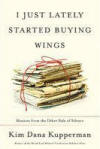I Just Lately Started Buying Wings
“Perhaps it’s the more subtle experience of relief as a kind of lifting up that most interests me,” says Kim Dana Kupperman in her collection’s opening essay, “Relief.” But what makes the compilation of linked essays interesting to readers? Through deftly untwining stories from her life, she manages to lift us up even as her topics are decidedly downers.
“Perhaps it’s the more subtle experience of relief as a kind of lifting up that most interests me,” says Kim Dana Kupperman in her collection’s opening essay, “Relief.” But what makes the compilation of linked essays interesting to readers? Through deftly untwining stories from her life, she manages to lift us up even as her topics are decidedly downers.
Death, child custody battles, domestic violence, failed relationships, and more death parade through the book’s pages. In three distinct essays, the author spreads ashes – her mother’s, her brother’s, and her father’s. Yet, there’s no whine or moan to these pieces. Rather, Kupperman observes, records, and reports to us remembered details of these incidents, giving voice to moments that often go unspoken, releasing them into the air like her loved ones’ ashes. In doing so, she makes us hear the sounds around her, feel the objects she’s handling, and know the heft of each memory:
You wrap and store the leftovers, wring out the sponge used to clean the counter, turn out the light on the fingerprints that linger on the refrigerator door. Later you touch and sort, discard or keep for another time all the artifacts that testify to a life that has passed – a tiny bear carved of jade on my mother’s perfume tray, a fur hat on my brother’s bureau that my father cannot wear but which fits me…
As she deals with the necessary “arrangements” for her brother who has died of AIDS, she says, “I like to think of him lifting off from the landscape of pain his body had become. Like the heron I once saw that unfolded its wings and levitated from the road.”
Kupperman “likes to think.” Period. Her skill with the essay form makes this clear. But nowhere is her prowess more evident than when she partners with her own lively imagination. In “Habeus Corpus,” for example, her dying father finally presents her with the court transcripts from her parents’ custody battle for the 8-year-old Kimmie. Despite the pages and pages of orders, writs, and testimonies, the author must still supplement the documents with imagined nuances of detail: “Angry that things weren’t going her way, my mother would have suddenly appeared taller than she was; her very dark brown eyes would have seemed hot if you could touch them.” She imagines her mother’s lawyer, Sidney Koblentz, “as a lunchtime Scotch drinker (straight, no chaser), with a taste for beautiful women, fast cars, and expensive suits.” Speculating on the omissions of her Russian émigré grandmother, Kupperman combines known facts with family legend to re-create Fanya Weckstein’s story: “My grandmother stands on the deck to take some air, the late winter sunlight twining in and out of her auburn hair, lightening her already pale green eyes … She talks of Chekhov, perhaps telling the young man that she feels like Masha in Three Sisters, dressed in black because she is ‘in mourning for my life.’”
“Acts of omission,” as the author calls them, become the focus of two of the essays, one about Kupperman’s family history, and another about the culture of silence that permeates the lives of the battered women with whom she once worked. In “Teeth in the Wind,” she posits that the details we omit in our own life stories define us as distinctly as those details we choose to include. And those stories trickle forward, coloring the family history for generations: “Perhaps we participate in acts of omission to shape memory into something manageable and safe. Who has the room inside their psyche to remember everything, carry the weight of how things felt, and still get out of bed each morning?”
In referring to the autobiographical essays as missives, Kupperman imbues them with an even stronger dose of the personal. And her ordering of essays, which defies a linear timeline, mimics the flow of a conversation between friends. One of the most innovative missives is “Nine Segments of Orange,” in which the author worries about the meaning of the color orange. The whole is composed of nine mini-essays, or segments, each considering a different aspect of the color: “For example, in foods I no longer eat – Creamsicles, Cheese Nips, and Orange Crush – but whose familiarity somehow anchors me.”
Neither last nor least, the book’s title essay reproduces a conversation in which the author asks an elderly woman friend to divulge her fried chicken recipe. The response is pure poetry, and worth the price of admission: “Her voice, like some holy place, issues from a warm brown prayer of a face.…When she’s done speaking, she rocks in her rocker, hands loosely clasped in her lap. We sit in silence, the secret she has spoken floating between us as if it were a feather.”





